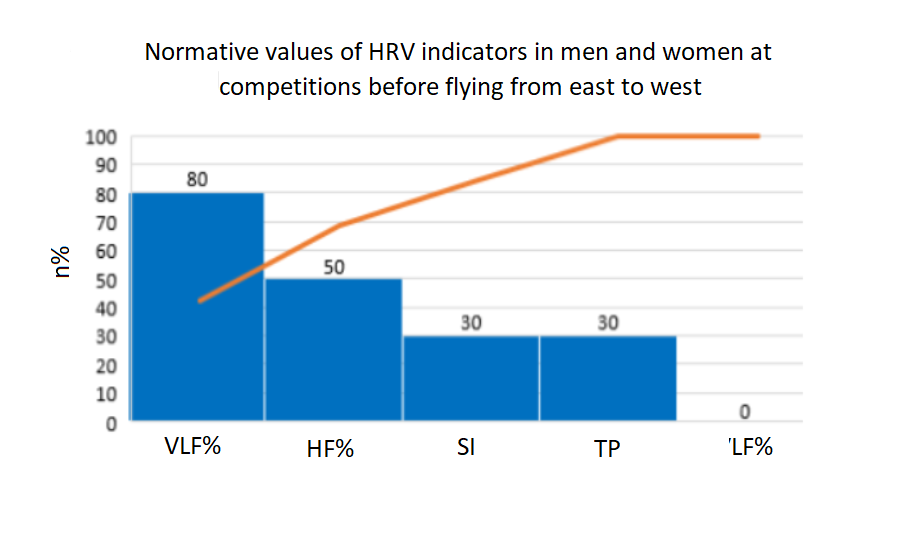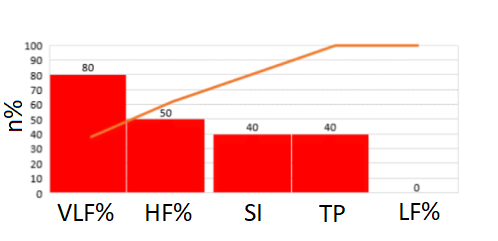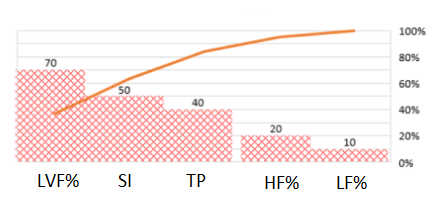Ecological and physiological assessment of the temporary adaptation of parachutists based on spectral analysis of ultradian rhythms to transmeridional flight
Ecological and physiological assessment of the temporary adaptation of parachutists based on spectral analysis of ultradian rhythms to transmeridional flight
Abstract
Results of a study of the temporal adaptation of parachutists according to spectral analysis (HF%, LF%, VLF%, TP) and the stress index (SI) of ultradian rhythms, taking into account the first type of transmeridional movement using the Pareto method. It was revealed that among the examined elite paratroopers there are risks of disadaptation and dyschronism, characteristic of the formation of pathological conditions. Both men and women showed desynchronosis according to LF%. The identified disorders are typical for classes 06, 07, 11 ICD-11 (international classification of diseases). Predictors of the ecological and physiological assessment of the temporary adaptation of skydivers to ultradian rhythms to transmeridional flight are the normalized power values of the heart rate variability spectra: HF%, LF%, VLF%, TP.
1. Introduction
Health is an important factor for athletic performance. Ecology, as a field of knowledge, establishes the patterns of interaction between organisms with each other and with the environment. Physic, chemical, biological, neuropsychogenic environmental factors, and their combinations refer to environmental effects on the functioning, condition, adaptation, activity, mobility, endurance, performance of the body – to all systems , . The human body can adapt to different environments by responding physically and mentally , . In recent years, the ecology of sports and physical culture has been intensively developing, studying the relationship between a person and the environment in conditions of muscle training under changing conditions of the human environment .
The temporal organization of physiological processes is a regularity of the life activity of the organism at all levels of the living system
. The body’s own rhythms are associated with fluctuations in the external environment. Different environmental conditions affect how the organism is organized , .Changing biological rhythms is crucial in preparing athletes for competitions. This is because athletes are traveling through more time zones to compete, and each athlete has an uncommon ability to adjust to new environments
, . Disturbance in the synchronization of body rhythms under the influence of exogenous and endogenous influences is accompanied by desynchronosis and characterizes pathological processes. When a person travels meridianally for more than two hours, the phase mismatch increases. The primary indicator of such movement is the angular velocity of movement, expressed in degrees of longitude, crossed per unit time . Five types of movement identified:1 – transmeridional movement with a change of time zones;
2 – trans latitudinal movement along the meridian from south to north or from north to south;
3 – movement along the diagonal with a simultaneous change in longitude and latitude, with many climatic zones and a significant change in standard time;
4 –moving to another hemisphere by crossing the equator;
5 – chrono-ecological regime, in which the oscillatory properties of the environment are sharply weakened or completely absent (asynchronous)
.Elite athletes competing internationally have concerns about the effects of jet lag on fitness and performance. This is because the rhythmic vibrations of biological systems control our habits and behaviors, which affect our daily activities
, .The circadian pacemaker (CR) in humans is the suprachiasmatic nucleus (SCN). Using information transmitted along the retina-hypothalamic pathway, the SCN coordinates daily biological rhythms: hormone production, temperature fluctuations, and neuronal activation under solar time and the sleep-wake cycle
, , . Research has shown that athletic performance peaks when the body is in its best position throughout the day. At this time, the person will have better mental muscle performance, reaction time, and body temperature. The hormonal response to CR varies, and different daily levels may influence athletic performance , .After a transmeridional flight, described in the literature as jet lag, the internal clock is desynchronized and several days are required to restore the body and adapt to new conditions
, , , . This phenomenon can disrupt sleep, concentration, and work efficiency, and cause fatigue and mood changes , . Changing time zones usually accompanied by unpleasant symptoms, desynchronosis, or dyschronism [9]. Individually and collectively, athletic performance affected by an irregular schedule and poor quality of sleep, drowsiness, daytime fatigue, and suboptimal diet. Changes in sleep-wake cycles determine the physical performance of athletes , , , .Today, paid much attention is to the study of temporal indicators of ultradian rhythms. These rhythms are not well understood today.
By studying environmental and physiological markers, we can determine how jetlag affects elite athletes’ sporting achievements.
This study examines how skydivers adapt during transmeridional flights by analyzing their ultradian rhythms.
2. Research methods and principles
It is important to study the physical condition of athletes in any sport to prevent health issues and monitor their adaptation. Pre-nosological studies help identify predictors of athletes’ health, physical performance, and injury prevention, especially in jet lag conditions.
EFSMA has created a standard for elite athletes that involves ECG screening using specialized digital equipment. In this work, a non-invasive method of heart rate variability using the software and statistical complex “Varicard-6.0” in statistical processing “ISCIM-6”. An analysis of spectral indicators of heart rate variability in the control of heart rhythm regulation, having a log-normal distribution, is given: TP ms – the total level of activity of regulatory systems; HF ms – level of parasympathetic activity; LF ms – level of activity of the vasomotor center; VLF ms – level of activity of the sympathetic circuit. And normalized HVR values: HF% – relative level of parasympathetic activity; LF% – relative level of activity of the vasomotor center; VLF% – relative level of activity of higher vegetative centers; SI – stress index (degree of tension in regulatory systems). A.N. Fleishman [8] contributed undoubtedly to the theoretical and practical study of spectral characteristics or slow fluctuations of hemodynamics.
The data were processed mathematically (M±m; ±σ) and statistically, identifying the significance of differences using the students' φ-test and correlations (r). The ecological-physiological assessment was determined by selected HVR indicators under the Pareto law.
The sample consisted of elite skydivers (n=20 people; men – 10; women – 10). During the international competitions, we conducted measurements while the elite skydivers were at rest, sitting, after completing each flight mission, before the transmeridional east-west flight (Central Russia – Arizona, USA), and after (west-east). Arizona City (USA) and Moscow (Russia) have a time difference of 10 hours 00 minutes. This falls under the first type of transmeridional movement with a change of time zones.
3. Main results
Elite skydivers competed in international competitions in Central Russia before their cross-continental flight. Analysis of normalized values of heart rate variability showed that in men and women VLF% corresponds to the Pareto law. In men, this value characterizes the norm (80%), in women it is slightly below the norm (60%). There were no significant differences between men and women in HF%, SI, TP. Violations of normalized values for HF% indicators was observed in 50% of men and 80% of women, and LF% – in 100% of men and 90% of women (Fig. 1).

Figure 1 - Normative values of HRV indicators in men and women at competitions before flying from east to west in accordance with Pareto’s law

Figure 2 - Normative values of HRV in men and women during competitions after flying from west to east

Figure 3 - Normative values of HRV in men and women during competitions after flying from west to east
Table 1 - Formation of pathological processes in elite skydivers before (east-west) and after (west-east) trans-meridional flight
Indicators | Men n % | Women n % | ||||
before | after | m | before | after | m | |
TP ms | 70 | 60 | 65 | 60 | 60 | 60 |
HF% | 50 | 50 | 50 | 90 | 80 | 85 |
LF% | 100 | 100 | 100 | 90 | 80 | 85 |
VLF% | norm | norm | norm | norm | norm | norm |
SI in | 70 | 60 | 65 | 80 | 50 | 65 |
In women, the tension of regulatory systems increased and the total power of the heart rate variability spectrum decreased. Correlation analysis revealed the formation of pathological processes in parachutist athletes both before and after a transmeridional flight (Table 2).
Table 2 - The relationship (r) between the indicators of the spectral power of harmonics in male and female elite skydivers under the conditions of the first type of trans-meridional flight
Men | Values | Women | ||
after | before | before | after | |
0,91 | 0,85 | TP-HF | 0,72 | 0,59 |
0,64 | 0,62 | TP-LF | 0,94 | 0,94 |
0,96 | 0,94 | TP-VLF | 0,84 | 0,48 |
0,51 | 0,32 | HF-LF | 0,51 | 0,34 |
0,81 | 0,70 | HF-VLF | 0,71 | 0,47 |
0,48 | 0,52 | LF-VLF | 0,67 | 0,27 |
-0,64 | -0,65 | SI-TP | -0,92 | -0,89 |
-0,51 | -0,58 | SI-HF | -0,78 | -0,76 |
-0,79 | -0,64 | SI-LF | -0,84 | -0,77 |
-0,52 | -0,47 | SI-VLF | -0,78 | -0,47 |
The results of the study showed that under a complex of such stress factors as:
- participation in competitions,
- transmeridional flight,
- natural,
- climatic and
- weather (air temperature, humidity, atmospheric pressure, altitude),
- the ecology of the competition site,
female elite athletes experience dyschronism based on specific indicators and cardiovascular issues. In male paratroopers, a pathological state of the cardiovascular center (LF%) was established, which characterizes the preconditions for diseases of the cardiovascular system and desynchronosis. LF waves are dominant, and women have both HF and LF waves, with normal VLF values. This shows a decrease in sympathoadrenal activity during exercise and can be a sign of prognosis.
It should be noted that the body’s adaptation resources are determined by the synchronization of the time ranges of adaptation mechanisms. Correlation analysis showed that in men before the flight (r=0.94; P<0.001) and after (r=0.96; P<0.001), synchronization of heart rhythm control was carried out by the power of the sympathetic control of heart rhythm regulation, which show ergotropic influences on the adaptation process. In women, synchronization of heart rhythm control was noted by the influence of the activity of the vasomotor center, which is characteristic of the vagoinsular branch of the baroreceptive reflex (Table 2).
It should be noted that before and after the transmeridional flight, men, and women showed a high level of correlation between the total power of harmonics (TP) and the power of spectral components (HF, LF, VLF), as well as between frequency components. This shows the mutual transition of spectra and formed resistance to a complex of stress factors of different nature. This phenomenon indicates that the body of skydivers can prevent life-threatening conditions, which can be considered as rheostasis. Based on the results obtained, it can be assumed that, in men, ergotropic influence controls the adaptation mechanism, and in women by the sympathetic and vagoinsular branches of the baroreceptive reflex.
The study showed that there is an inverse correlation between the values of spectral power and the voltage of regulatory systems.
4. Discussion
The results of a study of the temporary adaptation of skydivers according to spectral analysis (HF%, LF%, VLF%, TP) and the stress index (SI) of ultradian rhythms, whereas transmeridional flight under the Pareto law, showed that the examined elite skydivers have risks maladaptation and dyschronism characteristic of the formation of pathological conditions. Both men and women showed desynchronosis according to LF%. The identified disorders are typical for classes 06, 07, 11 ICD-11 (international classification of diseases). The factors that can help predict how skydivers adapt to ultraradian rhythms, considering transmeridional flight, are the normalized power values of heart rate variability spectra: HF%, LF%, VLF%, TP.
The data analysis suggested that elite skydivers should adjust their sports routine to minimize stress.
1) develop models for regulating sports training and rest;
2) adjust the time of sleep and wakefulness, eating time;
3) study the control of the frequency of rest in the conditions of performing assigned tasks at competitions and monitor health indicators.
5. Conclusion
Athletes rely on their experience to deal with jet lag when preparing for competitions. This coaching approach enhances an athlete’s performance in competitions by focusing on ecological dynamics. It consists of the value and meaning of the athlete’s personal experience
, , . Training to handle stress in competitions helps athletes plan their abilities in the athlete-environment system. As a result, the athlete achieves “local and global” adaptation . When physical activity is decreased, it can help improve the capacity for innovative and adaptive self-regulatory behavior during skills practice . Sports science has seen an increase in using modern approaches to training design and skill development: for example, ecological dynamics and the sport skill model . This new way of preparing athletes for elite sports is different from the old methods that have been used for a long time. In this direction, researchers have conducted interesting work on utilizing the self-regulation system of athletes to prepare for participation in the Olympic Games .